

L'influence du pop art sur la publicité. Partagez-moi !
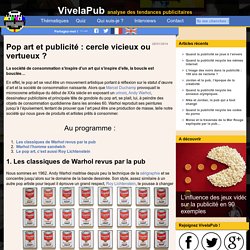
La société de consommation s’inspire d’un art qui s’inspire d’elle, la boucle est bouclée… En effet, le pop art se veut être un mouvement artistique portant à réflexion sur le statut d’œuvre d’art et la société de consommation naissante. Alors que Marcel Duchamp provoquait le microcosme artistique du début de XXe siècle en exposant un urinoir, Andy Warhol, dessinateur publicitaire et principale tête de gondole du pop art, se plait, lui, à peindre des objets de consommation quotidienne dans les années 60.
Warhol reproduit ses peintures jusqu’à l’épuisement, tentant de prouver que l’art peut être une production de masse, telle notre société qui nous gave de produits et artistes prêts à consommer. Au programme : Pop Art à l'école. Projet 2008-2009 Autoportrait sous influence d'Andy Warhol.
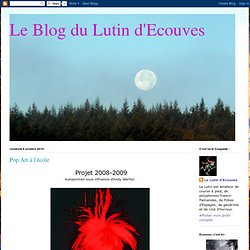
L'Artiste de cette année de Ce2 (8 à 9 ans) a été "The Pope of the Pop Art" : Andrew Warhola, dit "Andy Warhol". Etape 1 : Autoportrait au crayon. 35 millions de dollars pour une bouteille de Coca Cola de Warhol. Le lot de 54 oeuvres d'art d'après-guerre et contemporaines mises en vente a trouvé preneur à 91% pour un total de 222,4 millions de dollars, commissions incluses.
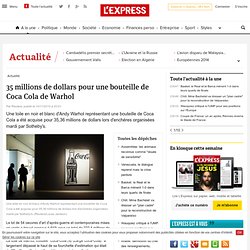
La toile de Warhol, intitulée "Coca-Cola (4) (Large Coca-Cola)" a largement dépassé le haut de sa fourchette d'estimation qui était de 25 millions, illustrant l'appétit croissant des collectionneurs pour l'art d'après-guerre. D'autres ventes marquantes furent celles d'oeuvres de Gerhard Richter acquises pour 13,23 millions et 11,3 millions, et "Figure in Movement" de Francis Bacon cédée pour 14 millions, chacune ayant été attribuées pour plus du double de leur estimation basse. En tout, six oeuvres ont dépassé les 10 millions de dollars, dont une oeuvre sans titre de Rothko acquise pour 22,5 millions de dollars.
Ce marché, ainsi que l'intérêt pour l'art contemporain, s'est développé au cours des dernières années, éclipsant parfois la demande pour les artistes impressionnistes ou "modernes". FRANCE 24 - Hollywood, Warhol et Barbie ont fait d’Elizabeth Taylor une véritable icône. The Failsafe Gift Guide - Andy Warhol 'Giant' Size.
As Christmas gift buying can occasionally be an unwelcome challenge - pulling mental resources together to formulate an exact idea of what your loved ones' hearts might desire - we're here to help.

Today we have the perfect book for any art/celebrity/photography lover to leaf through on Christmas afternoon – Andy Warhol “Giant” Size. Over 24 years have gone by since Warhol’s death but, as perhaps the most famous artist of the 20th century, his life and work continues to be a source of endless fascination to anybody interested in art and pop culture. Andy Warhol “Giant” Size brings together the key moments, major events, people and works from the artist and filmmaker’s career. Letterheady - andy warhol. Fuck Yeah Warhol Factory.
Andy Warhol eating a hamburger. Campbell’s Celebrates Andy Warhol with 50th Anniversary Soup Cans. In celebrating the 50th anniversary of Andy Warhol‘s iconic 32 Campbell’s Soup Cans (1962), Campbell’s is set to introduce limited edition versions of its tomato soup cans with labels reflecting Warhol’s signature pop-art style.
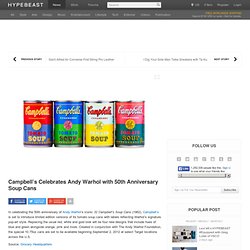
Replacing the usual red, white and gold look will be four new designs that include hues of blue and green alongside orange, pink and more. Created in conjunction with The Andy Warhol Foundation, the special 10.75oz cans are set to be available beginning September 2, 2012 at select Target locations across the U.S. Source: Grocery Headquarters. Campbell Celebrates Andy Warhol and 50 Years of Pop Culture History. To celebrate the 50th anniversary of Andy Warhol’s 1962 famed work, 32 Campbell’s Soup Cans, Campbell Soup Company is introducing limited-edition cans of Campbell’s Tomato soup with labels derived from original Warhol artwork.
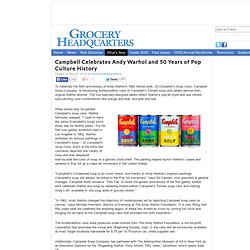
The four specially-designed labels reflect Warhol’s pop-art style and use vibrant, eye-catching color combinations like orange and blue, and pink and teal. When asked why he painted Campbell’s soup cans, Warhol famously quipped, “I used to have the same [Campbell’s soup] lunch every day for twenty years.” For his first solo gallery exhibition held in Los Angeles in 1962, Warhol exhibited his famous paintings of Campbell’s soup – 32 Campbell’s Soup Cans. Each of the thirty-two canvases depicted one variety of soup and was displayed side-by-side like cans of soup on a grocery store shelf. The painting helped launch Warhol’s career and ushered in Pop Art as a major art movement in the United States. Life imitates art as Warhol-inspired soup goes on sale - News - Art. Campbell's Soup has launched a series of four canned tomato soups with labels that pay homage to Warhol's 1962 work of art "32 Campbell's Soup Cans.

" Timed to coincide with the 50th anniversary of Warhol's first solo exhibition, about 1.2 million cans of the tomato soup will be sold in Target stores across the United States for 75 cents each. The company's design team, working with The Andy Warhol Foundation for the Visual Arts, created four different labels in vibrant combinations such as pink and teal for the tomato soup that went on sale this month. "This is not something that we do everyday," said Liesl Henderson, director of communications for Campbell's Soup, adding that the Warhol Foundation was very protective of the artist's legacy. "But we've maintained a collaborative relationship with the Warhol Foundation over the years, and there's a fascination, it seems, with all things Warhol. " "Things like that had never been done before.
Andy Warhol paints Debbie Harry on an Amiga. The Invisible Photograph: Part II (Trapped) Part 2: Trapped: Andy Warhol's Amiga Experiments. Pop art. Un article de Wikipédia, l'encyclopédie libre.
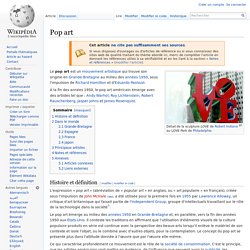
À la fin des années 1950, le pop art américain émerge avec des artistes tel que : Andy Warhol, Roy Lichtenstein, Robert Rauschenberg, Jasper Johns et James Rosenquist. Histoire et définition[modifier | modifier le code] Le pop art émerge au milieu des années 1950 en Grande-Bretagne et, en parallèle, vers la fin des années 1950 aux États-Unis. Il conteste les traditions en affirmant que l'utilisation d'éléments visuels de la culture populaire produits en série est continue avec la perspective des beaux-arts lorsqu'il enlève le matériel de son contexte et isole l'objet, ou le combine avec d'autres objets, pour la contemplation.
Le concept du pop art se présente plus dans l'attitude donnée à l'œuvre que par l'œuvre elle-même. L'accueil est très bon dès les débuts du mouvement, car le pop art est a priori simple et accessible. Dans le monde[modifier | modifier le code] Grande-Bretagne[modifier | modifier le code] Espagne[modifier | modifier le code] Lost-andy-warhol-artworks-recovered-after-spending-30-years-on-floppy-disks-9282576.
The doodles and photo manipulations were created by Warhol in 1985 as part of commercial stunt by Commodore to promote the graphical prowess of the company’s new Amiga 1000 computer.
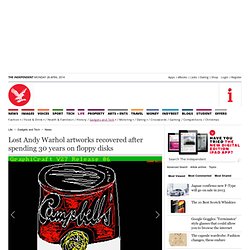
As well as reworking some of Warhol’s most famous themes, including images of a Campbell’s soup can and Marilyn Monroe, the artworks include a manipulated photo-portrait of Blonde’s Debbie Harry and three-eyed re-imagining of Boticcelli’s The Birth of Venus. The rescue of the artworks came about after chance viewing of a YouTube clip by new media artist Cory Arcangel. The clip in question (see below) was recorded as part of the launch event for the Amiga 1000 and shows Warhol making the portrait of Harry.
After Archangel saw the video in 2011 he contacted Tina Kukielski, a curator at the Carnegie Museum of Art and the pair got asked the chief archivist of the Warhol Museum, Matt Wrbican, if they could search for the artworks amongst his files. A manipulation of a pre-rendered Botticelli. Andy Warhol with “Flowers” in flowers, New York. Andy Warhol in a field of black-eyed Susans holding a bouquet of flowers with an early “Flowers” canvas serving as a backdrop.
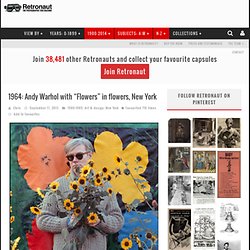
Andy Warhol's 85 Polaroid Portraits: Mick Jagger, Yoko Ono, O.J. Simpson & Many Others (1970-1987) Polaroid photography, which looked about to fade out forever for a while there, has in recent years made a comeback. Chalk it up, if you must, to a grand revaluing wave of the physically analog in our age of digital ephemerality — the same tide on which enthusiasm for vinyl, zines, and even VHS tapes has risen again. But we must acknowledge that Andy Warhol, in a sense, got there first. It hardly counts as the only matter on which the mastermind of the Factory showed prescience; take, for instance, his quip about everyone in the future getting fifteen minutes of fame, a prediction which, as Jonathan Lethem put it, has in our present hardened into “drab processional.”
Some of these very 21st-century people now enjoying (or enduring) their own fifteen minutes — most of them presumably not even born within Warhol’s lifetime — surely keep a Polaroid camera at hand. Andy Warhol. Un article de Wikipédia, l'encyclopédie libre. Andy Warhol Andy Warhol par Jack Mitchell dans les années 1960-1970. Œuvres réputées Andy Warhol, né le 6 août 1928 à Pittsburgh en Pennsylvanie[1] et mort à New York le 22 février 1987, est un artiste américain qui appartient au pop art, mouvement artistique dont il est l'un des innovateurs.